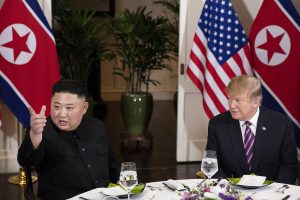US-DPRK Negotiations after Hanoi: Reconcilable Differences?

The latest US-DPRK summit’s abrupt end triggered a shockwave of confusion among the reporters and analysts in Hanoi to cover it, followed by competing accounts from President Trump and Foreign Minister Ri Yong Ho as to why the talks failed. In the days and weeks ahead there will no doubt be more leaks, claims and counterclaims about what—or who—was to blame for the inconclusive nature of the talks. Nonetheless, one thing seems clear: Donald Trump and Kim Jong Un went into Hanoi with very different positions on the scope of sanctions relief to be traded for initial North Korean steps on rolling back its nuclear program, and their meeting failed to bridge this gap.
In his post-summit press conference, President Trump claimed that “basically, they wanted sanctions lifted in their entirety.” Ri Yong Ho disputed Trump’s account, stating that Pyongyang only sought partial sanctions relief in exchange for an offer to dismantle the enrichment and plutonium production facilities at Yongbyon. However, as a senior State Department official pointed out, Ri’s definition of partial sanctions relief was broad, appearing to encompass all of the sectoral sanctions—on energy imports, coal exports, and more—imposed by a series of UN Security Council resolutions since 2016.
To the extent that President Trump’s negotiating team was prepared to offer sanctions relief at Hanoi, it was in a much more limited form. In the lead-up to the summit, the US signaled a slight softening of its position on sanctions, backing away from the stance that relief would only come after North Korean denuclearization. In a pre-summit interview with NBC News, Secretary of State Mike Pompeo said that sanctions pressure could be released once the US had “substantially reduced” the risk of North Korea’s nuclear program. Pompeo also told CNN that sanctions inhibiting “exchanges of people” and other sorts of confidence building measures could be relaxed if the negotiation process began to move forward, but insisted that “core sanctions” restricting North Korean trade and access to hard currency would remain in place.
The US and North Korean positions on sanctions relief were too far apart to be resolved over a few hours of high-level discussion in Hanoi, but these differences might not be insurmountable if both sides are willing to trade the glamour of summitry for the grindstone of working-level negotiations. In his post-summit remarks, Foreign Minister Ri declared that North Korea’s proposal on sanctions relief “will never be changed,” but left open the possibility that a “better agreement” might be possible. Ri also suggested that certain US “action in the military field” would be even more to Pyongyang’s liking than sanctions relief. President Trump, in turn, said that his negotiating team wanted more than Yongbyon on the table to offer the kind of sanctions relief Kim Jong Un was asking for.
Since a Yongbyon-for-sectoral sanctions trade clearly didn’t meet the Trump administration’s bottom line, negotiators could follow up either by trying to go bigger or by going smaller.
Going bigger might mean putting additional military confidence building measures to the table in exchange for North Korea’s willingness to allow access to critical facilities beyond Yongbyon, particularly undeclared enrichment sites. (Whether such confidence building measures would need to go significantly beyond the decision to end large-scale US-ROK spring military exercises remains to be seen.) Paring back or suspending sectoral sanctions in exchange for curtailing North Korea’s ability to produce additional nuclear weapons or delivery systems at these facilities might be a fair trade-off. It would make a relapse of the dynamics that almost led to war in 2017 less likely, while buying breathing space for a larger deal encompassing the removal of remaining sanctions, the normalization of US-DPRK relations, and the dismantlement of North Korea’s existing WMD stockpile.
If an ambitious approach fails to gain traction, going smaller could mean beginning with a freeze or limited dismantlement of facilities at Yongbyon in exchange for the facilitation of more people-to-people exchanges and non-commercial inter-Korean cooperation projects. This approach could also incorporate a pledge to ramp up humanitarian assistance to North Korea and to cut back the red tape hampering its delivery, and perhaps it could allow North Korea to barter sanctioned exports such as coal for supplies of food and medicine. Given reports of a poor harvest last fall, facilitating commercial food imports would be an important way to help the North Korean government address its stated concern about the impact of sanctions on the livelihoods of its people.
A deal touching on sanctions and nuclear facilities could be paired with the deliverables that Washington and Pyongyang appeared ready to agree upon in Hanoi, such as an end-of-war declaration, the exchange of liaison offices, a written North Korean commitment to end nuclear and long-range missile and rocket tests, and the expansion of remains recovery activities. The articulation of a road map laying out subsequent steps in the negotiating process, and of something approaching a common definition of denuclearization, would also be important elements at this stage.
But regardless of the specifics of any initial post-Hanoi agreement, it will be crucial that the negotiating teams on both sides be sufficiently empowered to get results. It is worth noting that Kim Hyok Chol, North Korea’s lead working-level negotiator, operates outside of the Foreign Ministry stovepipe as a representative of Pyongyang’s ruling State Affairs Commission, and is in a position to report directly to Kim Jong Un. Amidst a divided foreign policy team in the White House, Special Representative for North Korea Stephen Biegun will similarly need the active support of President Trump in order to succeed in what will surely be a challenging process ahead.
The views expressed in this article are solely those of the author and do not represent those of the National Committee on North Korea.
